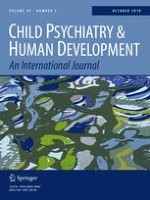17-02-2018 | Original Article
Do Callous–Unemotional Traits and Conduct Disorder Symptoms Predict the Onset and Development of Adolescent Substance Use?
Gepubliceerd in: Child Psychiatry & Human Development | Uitgave 5/2018
Log in om toegang te krijgenAbstract
Despite strong evidence of the relationship between conduct disorder (CD) symptoms and substance use, it is unclear how callous–unemotional (CU) traits predict substance use over and above CD symptoms, and their potential interaction. This study used data from 753 participants followed from grade 7 to 2-years post-high school. Latent growth curve models showed that CU traits predicted the onset of cigarette use, alcohol misuse, and a substance use composite at grade 7 only when no CD symptoms were present. Among those without CD symptoms, boys showed greater change in the odds of using cigarettes, and were more likely to misuse alcohol or use any substance at grade 7 than girls. However, CD symptoms, CU traits, and their interaction did not predict the linear rates of growth of substance use over time. Thus, CU traits may uniquely predict adolescent substance use when CD symptoms are not present. This research has implications for predicting onset of adolescent substance use and for incorporating the assessment of CU traits into interventions targeting adolescent substance use.
